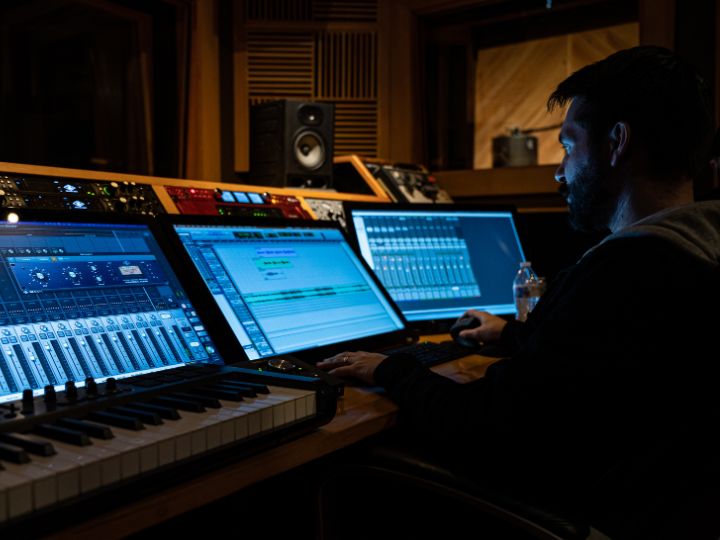Dubbing or Subtitling : What’s the Best Choice for Your Audience?
 March 6, 2025
March 6, 2025

The global entertainment industry is thriving as content breaks cultural barriers. As producers increasingly rely on digital platforms and localization needs rise, a crucial decision must be made between dubbing and subtitling.
Each has pros and cons, and the choice between them tends to be dictated by several factors, such as audience preference, budget, and the type of content being translated. This blog will unfold some major differences between dubbing and subtitling, thus helping you decide on a solution that works better for your audience.
 Movies that incorporate dubbing alter original vocal tracks with another language spoken by performers giving voice-overs in a different language. In this process, by matching lip movements and emotions indelibly with those of the original performance, professional voice actors re-record the dialogue. Dubbing services in India ensure accurate lip-syncing and script authenticity in voiceover production.
Movies that incorporate dubbing alter original vocal tracks with another language spoken by performers giving voice-overs in a different language. In this process, by matching lip movements and emotions indelibly with those of the original performance, professional voice actors re-record the dialogue. Dubbing services in India ensure accurate lip-syncing and script authenticity in voiceover production.
 Subtitling is when translated text reads at the bottom of the screen while the original sound continues. Professional subtitling services are in charge of ensuring that those subtitles are correctly synchronized with dialogues and provide appropriate translations without being distracting to the viewers. Reviewers share the common function of content dissemination to worldwide audiences despite exhibiting major variations in viewing characteristics between them.
Subtitling is when translated text reads at the bottom of the screen while the original sound continues. Professional subtitling services are in charge of ensuring that those subtitles are correctly synchronized with dialogues and provide appropriate translations without being distracting to the viewers. Reviewers share the common function of content dissemination to worldwide audiences despite exhibiting major variations in viewing characteristics between them.
 Many factors influence this choice between subtitling and dubbing, including the audience you want to target, budget, and types of content. Here are some primary points to consider:
Many factors influence this choice between subtitling and dubbing, including the audience you want to target, budget, and types of content. Here are some primary points to consider:
Understanding Dubbing And Subtitling
Before analyzing the advantages and disadvantages of dubbing and subtitling, it is essential to know what they entail.What Is Dubbing?
 Movies that incorporate dubbing alter original vocal tracks with another language spoken by performers giving voice-overs in a different language. In this process, by matching lip movements and emotions indelibly with those of the original performance, professional voice actors re-record the dialogue. Dubbing services in India ensure accurate lip-syncing and script authenticity in voiceover production.
Movies that incorporate dubbing alter original vocal tracks with another language spoken by performers giving voice-overs in a different language. In this process, by matching lip movements and emotions indelibly with those of the original performance, professional voice actors re-record the dialogue. Dubbing services in India ensure accurate lip-syncing and script authenticity in voiceover production.
What is Subtitling?
 Subtitling is when translated text reads at the bottom of the screen while the original sound continues. Professional subtitling services are in charge of ensuring that those subtitles are correctly synchronized with dialogues and provide appropriate translations without being distracting to the viewers. Reviewers share the common function of content dissemination to worldwide audiences despite exhibiting major variations in viewing characteristics between them.
Subtitling is when translated text reads at the bottom of the screen while the original sound continues. Professional subtitling services are in charge of ensuring that those subtitles are correctly synchronized with dialogues and provide appropriate translations without being distracting to the viewers. Reviewers share the common function of content dissemination to worldwide audiences despite exhibiting major variations in viewing characteristics between them.
Pros And Cons Of Dubbing
Pros Of Dubbing
- Enhanced Audience Engagement: Dubbing allows the viewer to be engrossed in the content without distraction from caption reading. This is particularly favourable for young viewers and those who prefer a more 'natural' viewing experience.
- Better Accessibility: Dubbing benefits viewers with visual impairments or reading difficulties by allowing them to experience dialogue through spoken audio rather than text.
- Perfect for Animated or Action-Packed Content: Dubbing shines when it comes to fast-paced action films, cartoons, and animated series, which allow the audience's great attention to go to visuals alone.
- Expanding Market Reach: Creating quality dubbing in a post production studio expands its market reach by reaching out to those audiences who may not find comfort in reading subtitles, especially in countries where literacy rates vary.
Cons Of Dubbing
- High Costs: Dubbing costs more than subtitling because it requires professional voice actors, recording sessions, and post-production editing.
- Synchronizing Challenges: Lip-syncing can be a challenge here, especially for languages that have a completely different structure.
- Loss of Original Performance: Others feel that after-the-fact voiceovers are incapable of transmitting the original emotional impact of acting, which can enhance the mood.
The Pros And Cons Of Subtitling
Pros of Subtitling
- Cost-Effective: Subtitling can be considered the best alternative to dubbing from the cost point of view, as it requires far fewer resources. Professional subtitling services can quickly and efficiently do the job within the shortest time frame, making them an obvious resource to utilize for companies working with a low budget.
- Preservation of Original Performance: Viewers can hear the original voice and, therefore, the natural emotions and intonation of the actors while still being able to understand the dialogue.
- Quick Turnaround Time: Subtitling is much faster than dubbing, which is why it comes in handy for companies and content creators who need to get their content out quickly.
- Helps Language Learning: To learn a language properly, one should follow written translation along with original audio; therefore, subtitles do this work for the learners.
Cons of Subtitling
- Calls For Reading: Some viewers, especially those with a more relaxed viewing style, will struggle with the constant reading that subtitles require.
- May Distract From Visuals: It may create a distractive ambience from such visuals. Indeed, since subtitles are always at the bottom, they tend to divert attention from the points of interest to which visual detail has to be painstakingly paid attention.
- Never Ideal for All Kinds of Content: Often, there are specific, extremely rapid films or close-ups of the scene that need one's complete attention. Within narrow timeframes like that, watching subtitles while the action is going on creates quite a difficult experience and can easily mean losing out on a dialogue or sometimes even a crucial event.
How To Choose Between Dubbing And Subtitling?
 Many factors influence this choice between subtitling and dubbing, including the audience you want to target, budget, and types of content. Here are some primary points to consider:
Many factors influence this choice between subtitling and dubbing, including the audience you want to target, budget, and types of content. Here are some primary points to consider:
- Audience Preference
- Budget Limits
Type of Content
- Movies: Both work, but mainstream audiences prefer dubbing.
- Documentary and Educational Videos: Almost all documents are subtitled because the original narrated authenticity is carried over to the subtitle.
- Animated Content: Typically, for characters and their expressions, dubbing works better.
- Time Turnaround
End Note
The choice between subtitling and dubbing purely depends on the aim and audience consideration. They have their own merits, and in some cases, the best result may be achieved through a combined method. The addition of subtitles would further expand your target audience when you release a main audience-dubbed version. Partnering with a professional dubbing or subtitling service, such as Naksh N Daksh Productions, ensures effective content localization. Whether an action or learning documentary is a global business presentation, the answer lies in identifying the right localization strategy.Latest Blog Posts
Have an idea?
Let’s Talk.!
We create experiences that fuel connections between brands and the people vital to their success.
Contact Us







